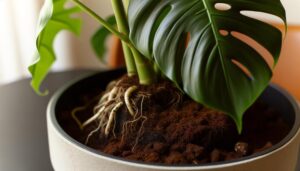How Big Do Monstera Deliciosa Grow?
Monstera Deliciosa, known for its distinctive split leaves, can reach a height of 4 to 10 feet indoors under best conditions. Outdoors, they may exceed 15 feet with adequate support and environmental factors.
Growth is influenced by light intensity, humidity, and nutrient availability. Proper soil composition and regular pruning are vital for controlling size and promoting healthy development.
Various cultivars, such as 'Borsigiana' and 'Albo Variegata', exhibit unique growth patterns and sizes. Ensuring ideal conditions like adequate lighting and soil quality is essential for maximizing their growth potential.
Further exploration provides detailed insights into optimizing their growth.
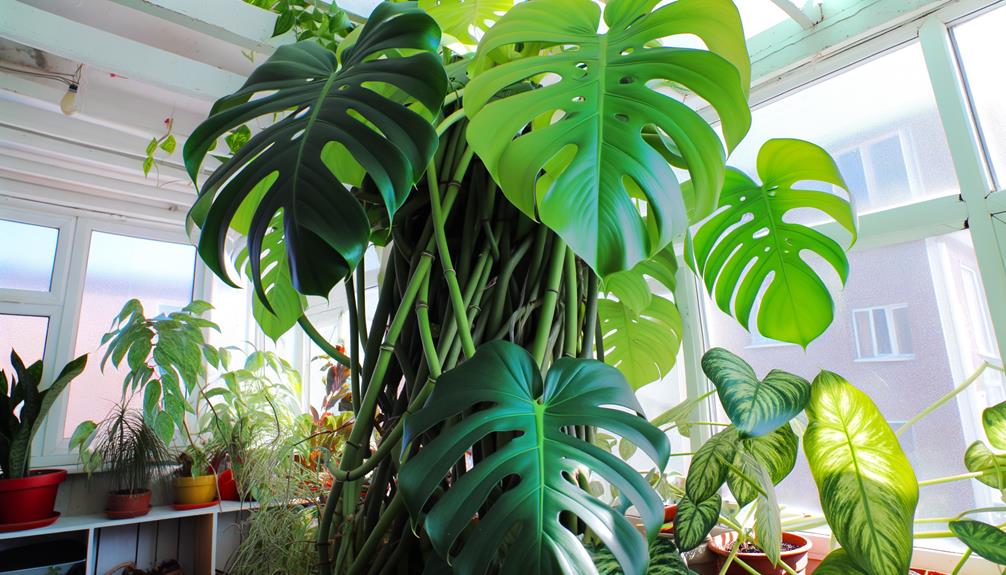
Key Takeaways
- Indoors, Monstera Deliciosa typically grows 4 to 10 feet tall.
- Outdoors, Monstera Deliciosa can reach heights of 10 to 15 feet or more.
- Different varieties, like 'Borsigiana' and 'Thai Constellation,' have varied growth potentials, usually between 5 to 8 feet indoors.
- Environmental factors such as light, humidity, and soil quality significantly influence growth size.
- Pruning can help control the plant's size and maintain desired shape.
Typical Indoor Size
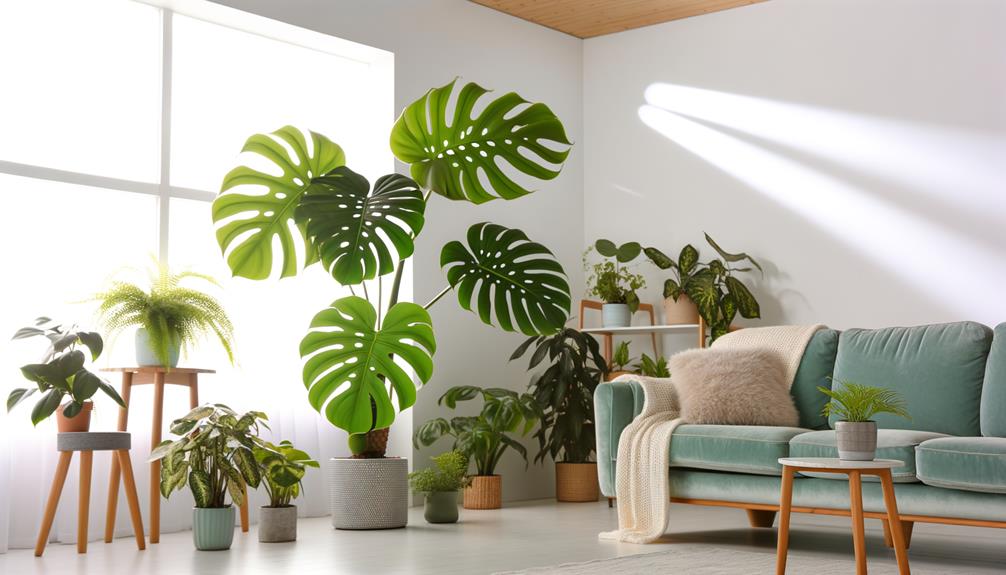
Monstera deliciosa, when cultivated indoors, typically attains a height ranging from 4 to 10 feet, depending on environmental conditions and care practices. The plant's growth is influenced by factors such as light exposure, humidity levels, and nutrient availability.
Best growth is achieved under bright, indirect light and high humidity, mimicking its native tropical environment. Regular fertilization with a balanced, water-soluble fertilizer supports vigorous development. Pruning can manage vertical growth and encourage lateral expansion, resulting in a fuller appearance.
Additionally, proper aeration and drainage in the growing medium prevent root rot and promote healthy growth. While indoor Monstera deliciosa plants generally exhibit constrained growth compared to their outdoor counterparts, they still require ample space for their expansive leaves and aerial roots.
Outdoor Growth Potential
In outdoor settings, Monstera deliciosa has the potential to achieve substantially larger dimensions, often reaching heights of 10 to 15 feet or more under ideal conditions. This robust growth is facilitated by the plant's natural climbing habit, allowing it to ascend trees and other structures.
The ample sunlight, increased humidity, and unrestrained root expansion typical of outdoor environments contribute significantly to its vigorous development. Additionally, the greater availability of nutrients in the soil further supports extensive foliage and root system expansion.
Notably, the leaves of Monstera deliciosa also exhibit increased size and fenestration when grown outdoors. This species thrives particularly well in tropical and subtropical climates, where its growth can be both rapid and expansive, creating an impressive botanical display.
Factors Influencing Growth
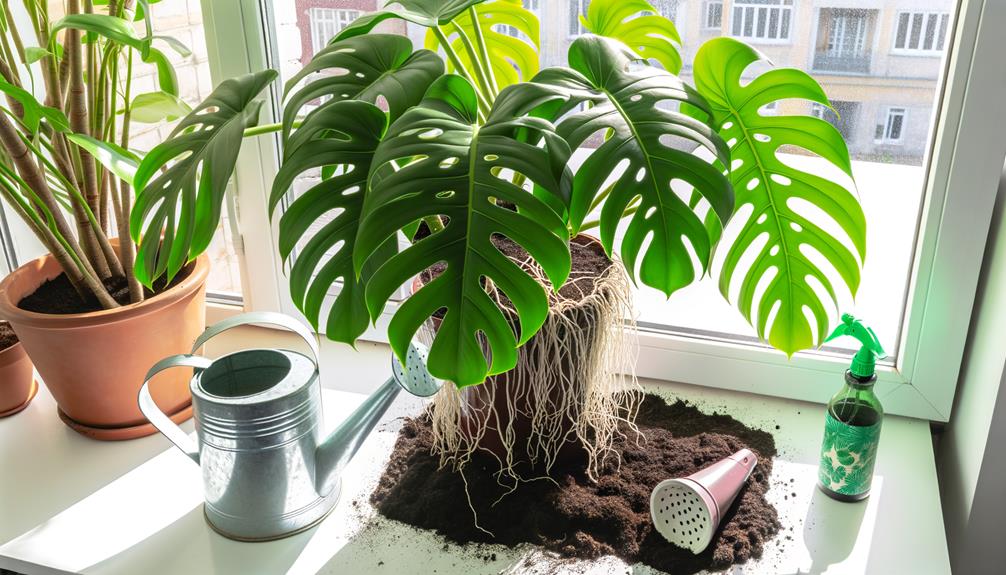
Several environmental and biological factors significantly influence the growth trajectory of Monstera deliciosa. These factors include light availability, soil composition, and humidity levels. Light intensity affects photosynthetic efficiency, thereby impacting growth rate and leaf size. Soil composition, particularly the balance of nutrients, determines root health and overall vigor. Humidity levels play an essential role in cellular turgor and transpiration processes, which directly influence leaf development and plant morphology.
The table below outlines key factors and their impacts:
| Factor | Influence on Growth | Importance Level |
|---|---|---|
| Light Intensity | Affects photosynthesis | High |
| Soil Composition | Nutrient availability | Medium |
| Humidity Levels | Cellular processes | High |
Understanding these factors is necessary for optimizing plant growth.
Ideal Growing Conditions
To optimize the growth potential of Monstera deliciosa, it is essential to provide specific environmental conditions. These include:
- Adequate light and temperature.
- Precise watering and humidity levels.
- Appropriate soil and fertilization regimens.
Each of these factors plays a significant role in ensuring the plant's development and overall health.
Light and Temperature Needs
Ideal growth of Monstera deliciosa is achieved under conditions of bright, indirect light and temperatures ranging from 65°F to 85°F (18°C to 29°C).
This species, native to tropical rainforests, thrives in environments that mimic its natural habitat. Direct sunlight should be avoided as it can cause leaf burn, while insufficient light may result in leggy growth and smaller leaves.
Temperature fluctuations should be minimized, as abrupt changes can stress the plant. Maintaining stable, warm conditions promotes vigorous growth and the development of characteristic fenestrated leaves.
The Monstera deliciosa does not tolerate cold drafts or temperatures below 50°F (10°C), which can impede growth and damage foliage. Ensuring appropriate light and temperature conditions is fundamental for best development.
Watering and Humidity Levels
Maintaining ideal watering and humidity levels is essential for the healthy growth of Monstera deliciosa. This tropical species thrives in consistently moist, but not waterlogged, soil. It is advisable to water the plant when the top 2-3 inches of soil are dry. Overwatering can lead to root rot, while underwatering may cause leaf yellowing and wilting.
Humidity levels should ideally be maintained between 60% and 80% to mimic the plant's native rainforest environment. Utilizing a humidifier or placing the plant on a pebble tray with water can effectively increase ambient humidity. Regular misting of leaves can also be beneficial.
Ensuring these conditions will promote vigorous growth and the development of characteristic fenestrated leaves.
Soil and Fertilization Tips
What constitutes the finest soil composition and fertilization regimen to ensure robust growth for Monstera deliciosa?
The ideal soil should be well-draining and rich in organic matter. A blend of potting soil, peat moss, and perlite is excellent.
Fertilization is vital during the growing season, typically from spring to early autumn. A balanced, water-soluble fertilizer with a 20-20-20 N-P-K ratio is recommended.
Here are four essential tips:
- Soil Composition: Use a blend of potting soil, peat moss, and perlite.
- Fertilizer Type: Select a balanced 20-20-20 N-P-K ratio.
- Fertilization Frequency: Apply every 4-6 weeks during the growing season.
- Soil pH: Maintain a slightly acidic to neutral pH (5.5-7.0).
Pruning for Size Control
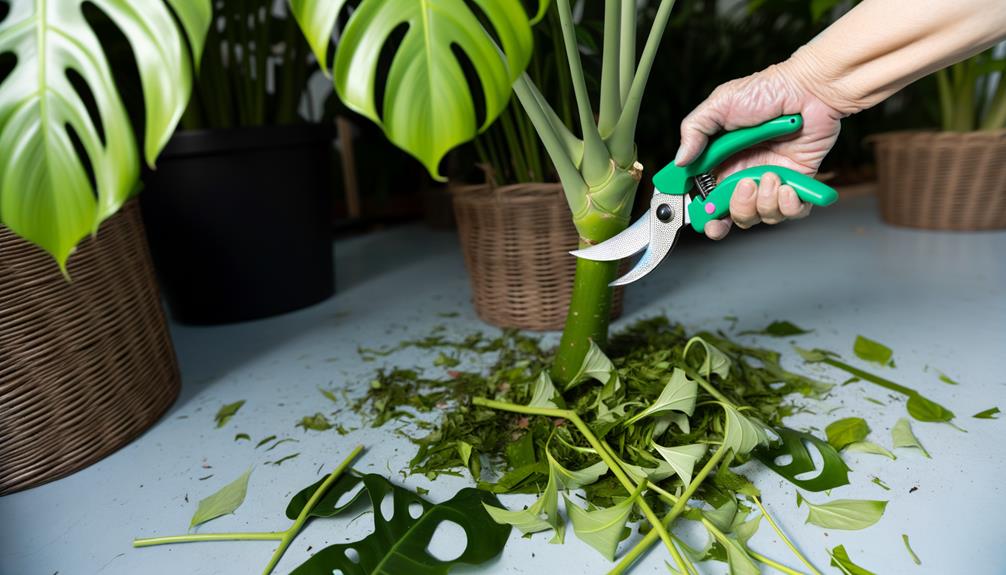
Pruning is an essential horticultural practice for controlling the size and shape of Monstera deliciosa, ensuring ideal growth and health. By strategically removing specific leaves and stems, one can manage the plant's dimensions and encourage more robust development.
This process involves using sterilized pruning shears to cut just above a node, promoting new growth from the cut site. Pruning also aids in the removal of damaged or diseased foliage, thereby preventing potential pathogen spread.
Additionally, routine pruning enhances light penetration and air circulation within the plant canopy, optimizing photosynthesis and reducing the risk of fungal infections. It is recommended to prune during the plant's active growing season, typically from spring to early autumn, for best results.
Common Growth Stages
Understanding the common growth stages of Monstera deliciosa is essential for maximizing pruning practices and ensuring the plant's overall health.
The growth trajectory of Monstera deliciosa can be delineated into four primary stages:
- Seedling Stage: Characterized by the emergence of small, heart-shaped leaves without fenestrations. The plant focuses on establishing a robust root system.
- Juvenile Stage: The leaves begin to develop fenestrations (holes), and the plant starts to climb, requiring support structures.
- Mature Stage: Exhibits fully fenestrated leaves and vigorous growth. This stage necessitates regular pruning to manage size.
- Reproductive Stage: The plant may produce flowers and fruit under ideal conditions, though this is rare in indoor environments.
These stages provide a framework for targeted care and effective growth management.
Comparing Varieties

To understand the growth potential of Monstera deliciosa, it is essential to compare the different varieties within this species.
This comparison will encompass variations in overall size, differential growth rates, and distinct leaf morphology.
Size Differences Explained
Among the various cultivars of Monstera deliciosa, notable differences in ultimate size can be attributed to both genetic factors and environmental conditions. These factors result in significant size variations among different varieties.
The key differences include:
- Monstera Deliciosa 'Borsigiana': Typically smaller, reaching up to 6-8 feet indoors, compared to the standard Monstera deliciosa.
- Monstera Deliciosa 'Albo Variegata': Exhibits variegated leaves and generally grows slower and smaller, often around 5-7 feet.
- Monstera Deliciosa 'Thai Constellation': Known for its unique variegation, but usually grows to 6-8 feet.
- Standard Monstera Deliciosa: The largest, capable of reaching 10-15 feet indoors with best conditions.
These distinctions are essential for horticulturists and plant enthusiasts aiming to select the appropriate cultivar for their specific space and aesthetic preferences.
Growth Rates Compared
The growth rates of Monstera deliciosa cultivars vary substantially, influenced by genetic predispositions and environmental conditions, requiring a detailed comparison to discern their relative development speeds.
Monstera deliciosa 'Borsigiana', a smaller cultivar, typically exhibits more rapid vertical growth compared to the standard Monstera deliciosa due to its less vigorous lateral expansion. Conversely, the Monstera deliciosa 'Thai Constellation', known for its striking variegation, often grows at a slower pace, attributed to the energy demands of maintaining its unique pigmentation.
Environmental factors such as light intensity, humidity, and soil nutrient availability further modulate these growth rates. Understanding these distinctions is vital for horticulturists aiming to optimize growth conditions and predict developmental timelines for different Monstera deliciosa varieties.
Leaf Characteristics Overview
Leaf morphology in Monstera deliciosa varieties exhibits significant diversity, characterized by variations in fenestration patterns, size, and coloration, which are critical for species identification and cultivation practices.
Notable differences include:
- Fenestration Patterns: Some varieties present large, well-defined splits and holes, while others exhibit minimal or no fenestrations.
- Leaf Size: Mature leaves can range from small (approximately 10 cm) to very large (up to 90 cm), depending on the cultivar and growing conditions.
- Coloration: Variations include deep green, variegated (green and white), and even shades of yellow or cream in some cultivars.
- Texture and Thickness: Leaves may vary from thin and delicate to thick and leathery, impacting their durability and aesthetic appeal.
Understanding these attributes assists in appropriate selection and care strategies.
Maximizing Growth Potential
To maximize the growth potential of Monstera deliciosa, it is essential to enhance environmental conditions such as light, humidity, and soil composition. Adequate lighting stimulates photosynthesis, thereby fostering robust growth; indirect sunlight is preferred to avoid leaf scorch. Humidity levels between 60-80% are ideal, replicating the plant's native tropical habitat. Soil should be well-draining, rich in organic matter, and slightly acidic to neutral (pH 5.5-7.0).
| Parameter | Enhanced Condition |
|---|---|
| Light | Indirect sunlight |
| Humidity | 60-80% |
| Soil Composition | Well-draining, pH 5.5-7.0 |
Regular fertilization during the growing season with a balanced, water-soluble fertilizer enhances nutrient availability, ensuring vigorous development. Pruning promotes airflow and mitigates pest infestations, supporting the plant's overall health.
Conclusion
To sum up, Monstera deliciosa displays notable growth variability, depending on environmental factors and care practices. Indoor specimens usually grow to heights of 6-8 feet, whereas outdoor counterparts can reach an impressive 30 feet. Growth is affected by light, humidity, and soil quality, with ideal conditions promoting strong development.
Pruning and comprehending growth stages play a role in managing size. As the saying goes, 'A plant well-cultivated is a plant well-developed,' emphasizing the significance of careful attention in maximizing growth potential.


